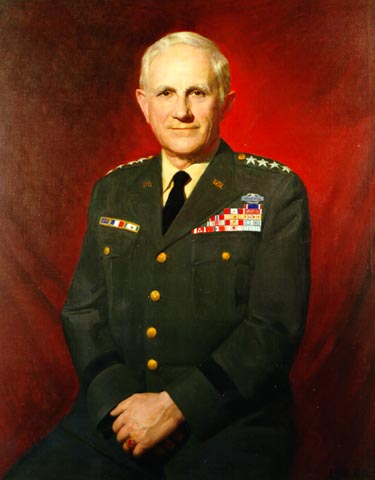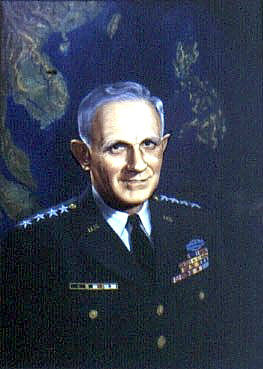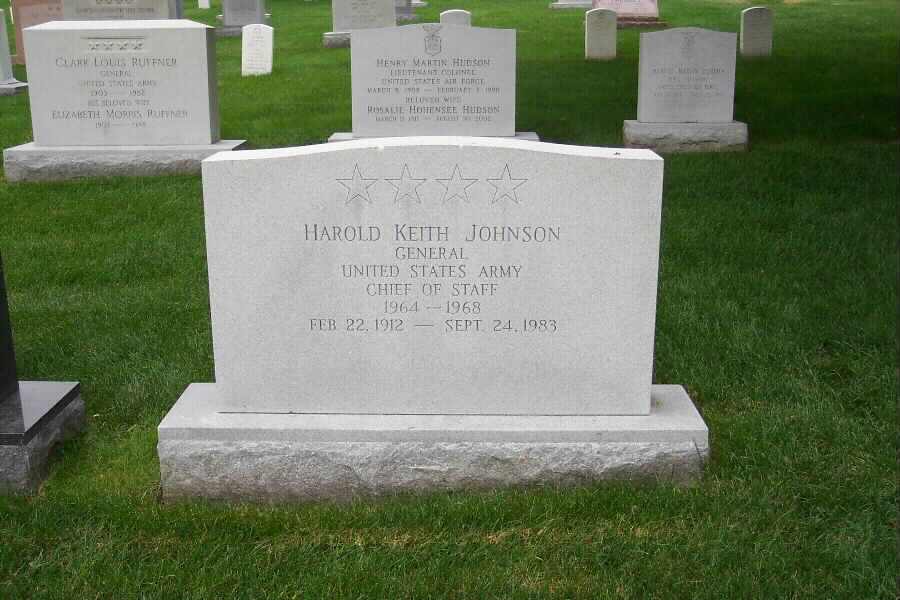Harold Keith Jjohnson was a professional soldier who became Chief of Staff of the United States Army in 1966. General Johnson was the youngest man to hold that position since General Douglas MacArthur.
Johnson was born in Bowesmont, North Dakota, in 1912. He graduated from Grafton High School in 1929, and the United States Military Academy in 1933.
Captain Johnson was operations officer for the 57th Infantry Regiment in Manila, prior to the Pearl Harbor attack by Japan. The 57th was ordered to Bataan where the Japanese were engaged. Johnson was promoted to Major and then Lieutenant Colonel and given command of the battalion. After a surrender to the superior Japanese force, Johnson and the 57th were forced on the Bataan Death March, which claimed 8,150 prisoners.
Johnson saw combat again in Korea, emerging from the conflict a full Colonel. In 1956, he was made a Brigadier General. In 1957, Johnson was named Chief of Staff of the US Seventh Army in Germany. General Johnson was chosen Chief of Staff to NATO’s Central Army Group in West Germany in 1959. In 1964, General Johnson was named Chief of Staff of the US Army and was awarded his fourth star.
Harold K. Johnson was born in Bowesmont, North Dakota, on 22 February 1912. He graduated from the United States Military Academy in 1933, was commissioned a Second Lieutenant, and was assigned to the 3d Infantry at Fort Snelling, Minnesota. In 1935, he married Dorothy Rennix.
In 1936, he was promoted to First Lieutenant and graduated from the Infantry School at Fort Benning two years later. Then he served in the 28th Infantry at Fort Niagara from 1938 to 1940. In 1940, he was assigned to the 57th Infantry, Philippine Scouts. Johnson also received a temporary promotion to Captain.
Johnson served as a battalion commander in the Philippines following the opening of hostilities between Japan and the U.S. When Bataan fell, he was taken prisoner, survived the Death March and spent the remainder of the war as a prisoner of war. He received temporary promotions to major and lieutenant colonel, and to permanent Captain. Shortly after his liberation and the war, Johnson was promoted to temporary Colonel.
In 1947, Johnson graduated from the Command and General Staff School at Fort Leavenworth, then taught there until 1949. Johnson graduated from the Armed Forces Staff College in 1950; he then commanded the 3d Battalion, 7th Infantry.
During the Korean War, Johnson was a Battalion Commander of the 5th and 8th Cavalry. He then served as the plans and operations officer of the I Corps, Far East Command.
Johnson graduated from the National War College in 1953 and headed the Joint War Plans Branch, Office of the Assistant Chief of Staff, G-3, from 1954 to 1955. In 1956, Johnson was made a permanent Colonel and temporary Brigadier General. He successively served as the assistant division commander of the 8th Infantry Division, as chief of staff of the Seventh Army in Europe, and as chief of staff of the Central Army Group, North Atlantic Treaty Organization. In 1959, he was made a temporary Major General and in 1960 was promoted to permanent Brigadier General, and was the commandant of the Command and General Staff College until 1963. In 1963, Johnson was made a permanent Major General and temporary Lieutenant General; a year later he was promoted to temporary General.
From 1963 to 1964, Johnson served as the deputy chief of staff for operations. He then was the Chief of Staff of the Army from 3 July 1964 to 2 July 1968. During his tenure as Chief of Staff, Johnson led the Army during the expansion of the Vietnam War. He also oversaw operations in the Dominican Republic, the fielding of an airmobile division, and created the position of Sergeant Major of the Army. Johnson retired from active duty in 1968, relinquishing the post of Chief of Staff to General William Westmoreland.
In 1969 was chosen as President of the Herbert Hoover Presidential Library Association. He also served on the board of directors of several defense corporations.
He died in Washington, D.C., on 24 September 1983 and was buried with full military honors in Arlington National Cemetery (Section 30, Grave 430-2).
Lewis Sorley’s book Honorable Warrior: General Harold K. Johnson and the Ethics of Command offers welcome analytical insight into the character of an officer who, as Army Chief of Staff and member of the Joint Chiefs of Staff, numbers among the top Vietnam-era service leaders who have been harshly criticized by recent pundits.
The motto of Harold K. Johnson’s high school class might well express the prevailing theme in his life: “Built for character, not for fame.” That character was a result of an adolescence of hard work and seemingly limited opportunity. If his life had stayed on its original track, the depth of that character might never have been revealed.
Tests of character would soon find Johnson, however. First, he was accepted at West Point, receiving an educational opportunity he otherwise might not have been able to afford. He was commissioned in the Infantry in 1933, in a depression-era Army in which it was still possible for officers to take courses in equitation. It was an army that did not reward ambition–one of Johnson’s classmates calculated that, at the rate officers were being promoted, their class would be eligible for promotion to Lieutenant Colonel at age 24. Johnson was one of many officers who labored in obscurity to learn their trade in the United States and, later, in the Philippines. The greatest test of Johnson’s character came after the fall of Bataan, when he was captured by the Japanese. Both his captors and fellow prisoners recognized his integrity, and his personal example was vital in keeping him and his colleagues alive.
After his release, Johnson seemed headed back to obscurity, because his prisoner of war experience disqualified him for career-enhancing assignments. Then the Army went through the trauma of the Korean War, during which officers of Johnson’s character were badly needed. He commanded an infantry regiment in Korea, winning the Distinguished Service Cross.
In Sorley’s depiction, by the time of Johnson’s service as DCSOPS in 1963 and Army Chief of Staff from 1964 to 1968, he was an officer whose innate decency had been forged into unassailable integrity. During Vietnam, this integrity drove him to do his level best to balance his obligations to the Administration and to the Army. If he fell short, it was not for a lack of desire to serve his country well, but as a result of institutional factors outside his control.
We on the eve of the 21st century tend to view the recent past with condescension. We describe as “unprecedented” the challenges of technological and institutional change that confront us. Sorley offers a view of the Army in the 1960s that was nothing like the stagnant, hidebound institution some believe it was. That Army had to deal with an expansion from 960,000 to 1.5 million soldiers and the conversion of its divisions from pentagonal to brigade structure. Along with growth and divisional reorganization, the Army had to field a new organization, Special Forces, and realize a new operational concept, airmobility. Racial unrest and antiwar riots required troops to quell civil disturbances. Looming over all, the Vietnam War confounded senior Army leadership with strategic conundrums and insatiable resource demands. Civilian leaders who spurned military advice, those whom General Johnson characterized as “intellectual prostitutes” and “a sorry lot of people,” compounded these challenges. It is doubtful that today’s Army leaders would willingly trade their problems for Johnson’s.
In another review of this book (Assembly, September-October 1998), US Military Academy history professor Colonel Cole C. Kingseed criticizes Sorley for joining “an increasing chorus who find [General William C.] Westmoreland a convenient scapegoat for American failure to achieve a military victory.” As Sorley portrays it, however, Harold K. Johnson’s problems with Westmoreland involved more than matters of military judgment. In Westmoreland’s 1976 autobiography, A Soldier Reports, he condones a deceptive argument for post-Tet reinforcement of American forces on the grounds of expediency: Who among the civilians would appreciate a policy of exploiting the enemy’s defeat, of reinforcing success? Having read their newspapers, who among them would even believe there had been success? Better to exploit their belief in crisis to get the troops, then argue new strategy later.
It is hard to imagine an officer of Harold K. Johnson’s uncompromising integrity approving this kind of misrepresentation, regardless of the benefit.
The most vexing question Sorley raises is whether Johnson should have resigned to protest the President’s manner of prosecuting the war. It is difficult to judge fairly. Given Johnson’s background and the situation as he knew it at the time, it would seem he was programmed to do what he did (although he was extremely self-critical on this point). Johnson’s character had been solidified in the days following Pearl Harbor when the Army was in worse shape than in Vietnam and pitted against a seemingly more formidable foe than North Vietnam. Further, had he resigned, he might have been replaced with someone of less moral conviction. Resignation must have seemed a defeatist choice, tantamount to abandoning his post. Johnson seems to fall into that category of leader Walter Cronkite (in his 27 February 1968 broadcast, revealing his loss of faith in the war) called those who “lived up to their pledge to defend democracy, and did the best they could.”
At the end of the book, describing Harold K. Johnson’s interment, Sorley tells us that he was “laid to rest at Arlington National Cemetery, side by side forever with those young soldiers whose early deaths had filled his eyes with tears.” This passage works as a metaphor, but the Vietnam-era dead are not actually near Harold K. Johnson’s grave. There is, however, a certain appropriateness in the place selected for his remains. He lies next to General of the Army Omar Bradley, and near the graves of Generals Earl Wheeler, Lyman Lemnitzer, and J. Lawton Collins. Nearby is General Max Thurman, his gravestone inscribed with the words that will always be associated with him, “Be all you can be.”
Cemeteries are good places for contemplation, and this book as well provides ample material to contemplate. For anyone who has read it, the question hanging over Harold K. Johnson’s grave is not why his generation of senior Army leaders performed so poorly, but whether under the same circumstances the current generation would have done as well.

Michael Robert Patterson was born in Arlington and is the son of a former officer of the US Army. So it was no wonder that sooner or later his interests drew him to American history and especially to American military history. Many of his articles can be found on renowned portals like the New York Times, Washingtonpost or Wikipedia.
Reviewed by: Michael Howard



